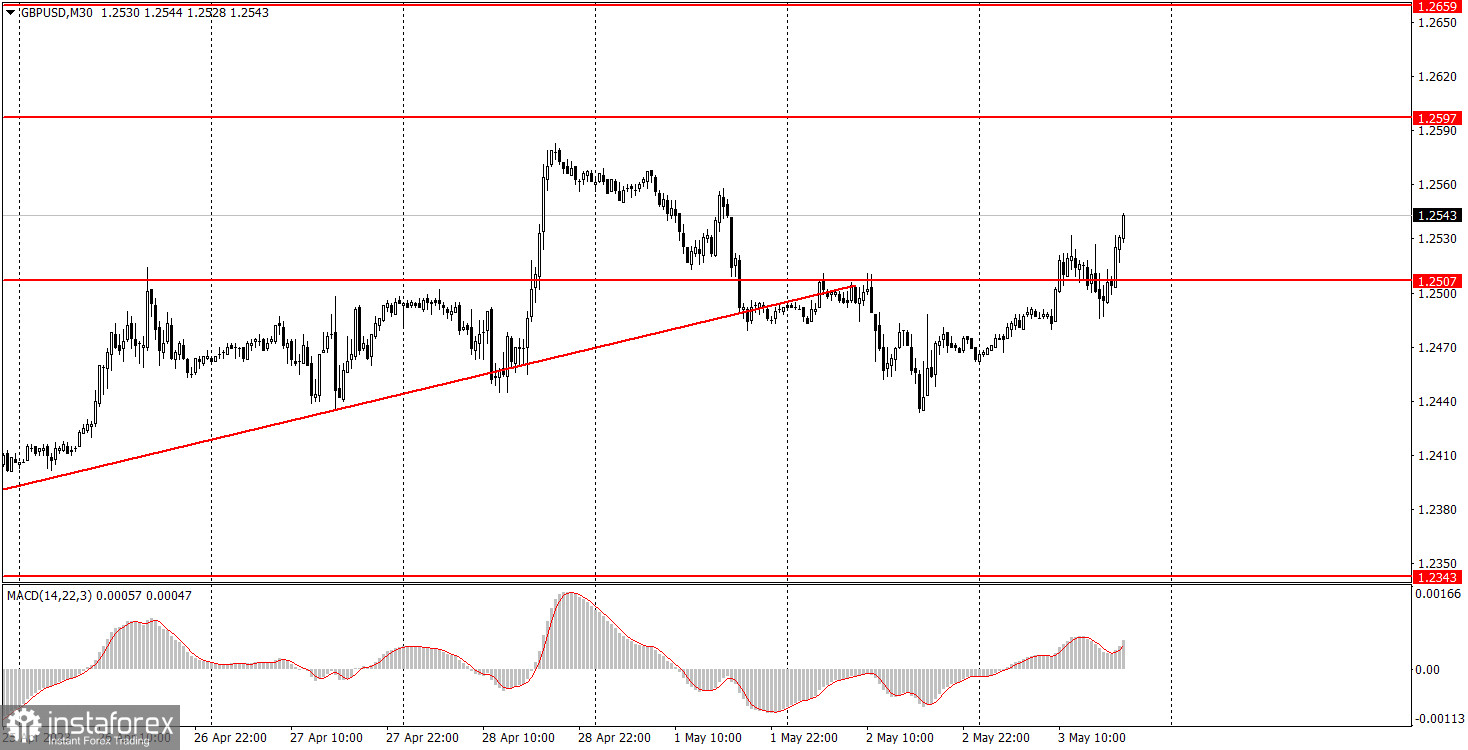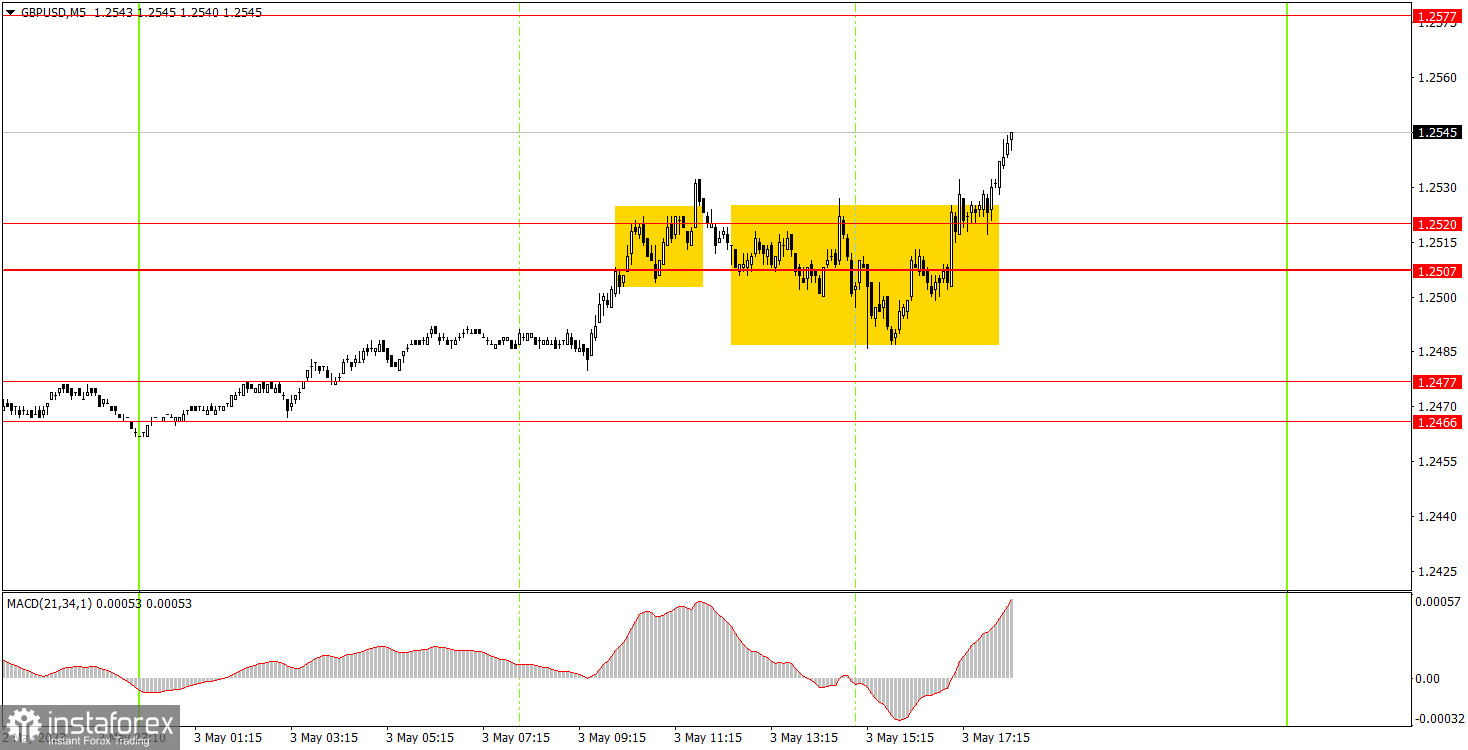Analyzing Wednesday's trades:
GBP/USD on 30M chart

The GBP/USD pair also started a new upward movement on Wednesday. It is difficult to justify the pound's growth. There were no important events or reports in the UK, and two relatively important reports (ADP and ISM) were released in the US, both stronger than forecasts and both should have triggered the dollar's growth. But obviously the dollar did not rise because the market continues to constantly press the "buy" button, ignoring any fundamental and macroeconomic background. In this regard, Monday and Tuesday, when the movements were at least slightly logical, look like an exception. On Tuesday, the pair consolidated below another ascending trendline, and on Wednesday it did what? That's right, it started rising again. However, we have repeatedly warned traders about such illogical market behavior. Even if the market is now working out possible dovish statements by Fed Chairman Jerome Powell, it still isn't an explanation. In the same way, any movement in the market can be explained.
GBP/USD on 5M chart

The trading signals on the 5-minute chart were not the best, as the pair traded between two areas that can be combined into one. There was a distance of about 30 points between these areas, so when forming a signal, the price was almost immediately near the target level. And the potential profit was at the level of 10 points. With such initial data, opening positions simply did not make sense. The buy signal on the European trading session and a similar buy signal on the US trading session should also not have been worked out because the potential loss exceeded the potential profit.
Trading tips on Thursday:
On the 30-minute chart, GBP/USD continues its upward movement in the medium-term or, at least, it doesn't trade lower, which is clearly visible on the 4-hour chart and higher ones. Most of the movements are illogical, as is the market reaction to fundamental and macroeconomic events. Overcoming the trendline gave the dollar absolutely nothing. On the 5-minute chart, it is recommended to trade at the levels 1.2245-1.2260, 1.2343-1.2360, 1.2396, 1.2466-1.2477, 1.2507-1.2520, 1.2577-1.2597-1.2616, 1.2659-1.2674. As soon as the price passes 20 pips in the right direction, you should set a Stop Loss to breakeven. On Thursday, the UK is set to publish its services PMI, and in the US, there will be a report on unemployment benefit claims. Despite the weak macroeconomic background, the pair may still trade in a very volatile manner due to the FOMC meeting and the euro's proximity.
Basic rules of the trading system:
1) The strength of the signal is determined by the time it took the signal to form (a rebound or a breakout of the level). The quicker it is formed, the stronger the signal is.
2) If two or more positions were opened near a certain level based on a false signal (which did not trigger a Take Profit or test the nearest target level), then all subsequent signals at this level should be ignored.
3) When trading flat, a pair can form multiple false signals or not form them at all. In any case, it is better to stop trading at the first sign of a flat movement.
4) Trades should be opened in the period between the start of the European session and the middle of the US trading hours when all positions must be closed manually.
5) You can trade using signals from the MACD indicator on the 30-minute time frame only amid strong volatility and a clear trend that should be confirmed by a trendline or a trend channel.
6) If two levels are located too close to each other (from 5 to 15 pips), they should be considered support and resistance levels.
On the chart:
Support and Resistance levels are the levels that serve as targets when buying or selling the pair. You can place Take Profit near these levels.
Red lines are channels or trend lines that display the current trend and show in which direction it is better to trade now.
The MACD indicator (14, 22, and 3) consists of a histogram and a signal line. When they cross, this is a signal to enter the market. It is recommended to use this indicator in combination with trend patterns (channels and trendlines).
Important announcements and economic reports that can be found on the economic calendar can seriously influence the trajectory of a currency pair. Therefore, at the time of their release, we recommend trading as carefully as possible or exiting the market in order to avoid sharp price fluctuations.
Beginners on Forex should remember that not every single trade has to be profitable. The development of a clear strategy and money management is the key to success in trading over a long period of time.
 English
English 
 Русский
Русский Bahasa Indonesia
Bahasa Indonesia Bahasa Malay
Bahasa Malay ไทย
ไทย Español
Español Deutsch
Deutsch Български
Български Français
Français Tiếng Việt
Tiếng Việt 中文
中文 বাংলা
বাংলা हिन्दी
हिन्दी Čeština
Čeština Українська
Українська Română
Română

